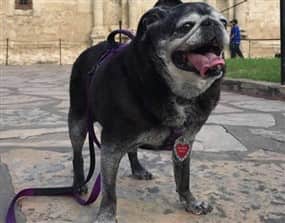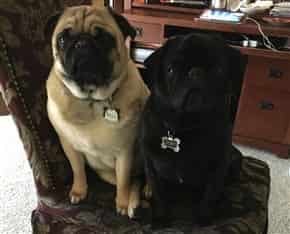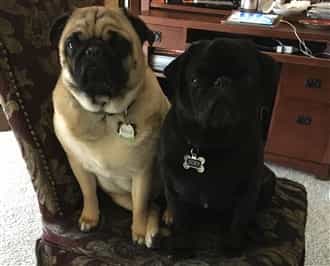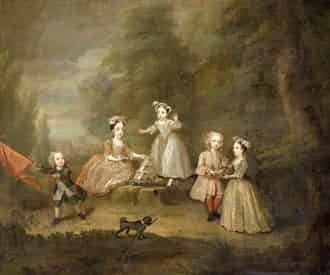Black Pugs
Overview
Pugs are found in two basic colors, black and fawn, plus silver-fawn and apricot-fawn (standard with clubs other than the AKC). Black is a very interesting coat color with the Pug; distinctive markings seen with fawns do not show on black Pugs, however, an all black Pug is extraordinarily beautiful.
This article will dive into the details about black Pugs including popularity, variations, possible markings, photo examples, mistaking brindle for black, coat aspects, questions regarding behavior, and origin.
Black Pugs in Kennel Club Breed Standards
Though there are variances in regard to non-black Pugs with all major kennel clubs, there is agreement across the board regarding black Pugs. It is a standard color with the AKC (American Kennel Club) as color S 007, the CKC (Canadian Kennel Club), the KC (the Kennel Club of the UK), and the FCI (Federation Cynologique Internationale, the largest federation of kennel clubs consisting of 90+ member countries).
How Common Are Black Pugs
If you've noticed that there are generally fewer photos of black Pugs than fawn Pugs or that you don't see black Pugs in person very often, this is because there really are fewer of them.
To determine more precisely how many black Pugs there are, we presented the question of 'What color is your Pug?' to 2693 Pug owners from the US, UK, Canada, Australia, and several other countries. This was part of a comprehensive survey consisting of appearance, health, and behavior questions and the full results are included in PetPugDog's GIANT Book of Pug Care.
The results were that of those 2,693 Pugs, just 22% had black coats, which were 593 Pug puppies and dogs. This can be compared 65% fawns, 4% apricots, 3% silver-fawns, 1% brindles, and 3% 'other' which included those whose owners were not sure about their Pug's color.
This polling suggests that a bit less than one-fourth of Pugs are black or in other words, 1 in 4 Pugs have black coats.
Variations with Black Pugs
In conformation show rings, all major kennel clubs expect black Pugs to be solid black. And, this is indeed what many black Pugs are, but there are some exceptions.
Black Pugs can have small markings, sometimes referred to as a mismark, which can occasionally be seen with Pugs of all colors. If this occurs, it is often a small white or light patch on the chest. Aside from this, there can be larger markings, seen as faults in the show ring, which may include a larger area of white on the chest or a scattering of lighter hairs throughout the coat.
Examples of Black Pugs
This is ZsaZsa, a 3 year old solid black Pug alongside Brutus, a fawn

photo courtesy of Kristina Olson
This is little Frank, a black Pug puppy at 9 weeks old
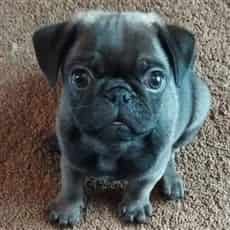
photo courtesy of Michelle
This is Penny, a solid black Pug puppy at 3 months old

photo courtesy of Tasha Riley
This is Lola, a 2-year-old female black Pug

photo courtesy of Sanchit Gupta
This is a closeup of Pearl, a female black Pug
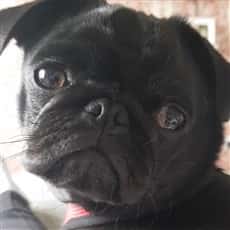
photo courtesy of Saz Race
This is Ellie, a black Pug (1 yr 9 m) with Nana Jr (1 yr 8 m)
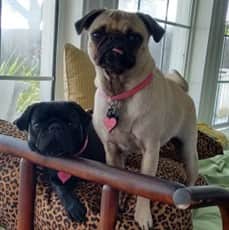
photo courtesy of the Piccardo and Moreno Family
Graying Hairs on Senior Black Pugs
Miss Moo, a 12 year old black Pug with lots of gray hairs on her face, chest, and legs.
This doesn't stop her from being active with her family, Jerry, Shelly and Taylor Koltz in Frisco, Texas
Just like humans, dogs can develop gray hairs as they age. It does not happen to all Pugs, but to a majority of them to some extent. While this will not be very noticeable on fawn Pugs, gray hairs on black Pugs stand out quite a bit. In some cases, graying will only be seen around the face, but other seniors can grow gray hairs on any other areas of the body.
The appearance of gray hairs with black Pugs may start as early as the 8-year mark, but is most commonly seen with those age 10 and up.
Mistaking Brindle for Black
Brindle is a pattern of interlocking striping colors and is not an accepted standard color for the Pug with any of the well-known kennel clubs. In fact, many wonder where this color came from or if it can even truly exist in the Pug bloodline.
Other breeds were used to develop the Pug which is where the pattern most likely came from; however, since it is not a color called out for in breed standards, most breeders do not aim to produce this and it is only seen sporadically.
As you can see with Luna here (photo below) who is a brindle, there is a lot of black in the coat. Yet, it is woven in with fawn as part of the brindle pattern. While she may have an overall appearance of a dark coat, this should not be confused with a true black coat.
photo courtesy of Brenda
Genes - Black vs Fawn
The black gene is the strongest and will rule over any other color, it is the dominant gene. This may lead you to wonder why there are more fawn Pugs than black ones. The main reason is that breeders choose more often to produce fawns.
If both colors were equally represented within all breeding programs, there would be many more litters of black Pug puppies than there currently are.
Each pup's color is determined by a pair of color genes, one comes from the dam, the other from the sire.
- If both genes in the pair are black, the Pug will be black.
- If one gene is black and the other is fawn, the pup will be black since it is the dominant gene and overpowers the fawn.
- If both genes are fawn, the Pug will be fawn.
Interestingly, despite their coloring, black Pugs carry the fawn gene, known as SS, though it is a recessive gene. The B gene produces the black coat color. Generally, it is not acceptable to breed a black Pug to a fawn. Crossing colors will not improve the coat or color of either type. Therefore, with no benefit to the pairing, most breeders will focus on one certain color. This said, due to recessive genes, a litter can consist of both fawn coats and black coats. In most cases, there will be more fawns, with a 3:1 ratio.
Physical Similarities and Differences Between Black and Fawn
Oscar and Zoey, both at 3 years old, photo courtesy of Julie
Similarities
- Black Pugs and fawn Pugs are alike in almost
every way. Size, body structure, ear set, bite set, tail shape, and eyes are all the same for all colors with this breed. While you may see black Pugs that are smaller than fawns, there are just as many that are larger. And while you may spot more fawns with double-curled tails, there are just as many black-coated Pugs with the double curl. Any physical differences that you may see are just a matter of those particular dogs.
Non-black Pugs have black ears and a black mask (black over the muzzle and around the eyes), and of course technically
this is there with black Pugs but is part of the dog's overall coat.
The toe nails on Pugs of all colors can be black or white, though black is preferred in conformation events.
Differences
- The one and only difference between the two colors is that some (but not all) black Pugs often have a single coat versus the double coat seen with most fawns. The double coat consists of both a soft and dense inner layer and a short, shiny outer layer. Black Pugs that have just the single layer will be missing the inner layer.
While you may not notice much of a difference by eye, you can often feel the difference when petting a Pug and this does affect how much a Pug sheds. With double-coats, there will be more shedding since the inner layer rapidly cycles, especially in the fall and spring. There is generally more upkeep needed with grooming tools to remove the dead hairs.
Personality Differences
There is much debate on whether coat color determines a Pug's personality. Some may say that black Pugs are better behaved, are more relaxed, or are less vocal than fawns. Yet, just as many will say the opposite.
The question of personality traits is one of nature versus nurture. Is behavior inbred or does a dog's environment and type of care received shape the personality?
It has been our experience that while genetic traits regarding temperament can be passed down, it is how a Pug is raised, trained, and treated that will have the biggest impact on that dog's overall behavior.
The Origin and Popularity Spread of Black Pugs
Unlike many other breeds whose development was meticulously recorded and those documents are preserved as part of history, the Pug's early development is shrouded in mystery.
General consensus is that the Pug originated in China thousands of year ago (at least 400 B.C.). Chinese drawings, carvings, and statues depicted dogs that were, most likely, ancient ancestors of the Pug. But, unfortunately, documents covering the very early development of Pugs was essentially erased from history when some time around 200-225 B.C. the Emperor Chin Shih Huang ordered that all records be destroyed to maintain the 'secrets' of this breed.
Yet, of course, moving further ahead in time, evidence and record-keeping started up again, including those connected to the appearance of black Pug dogs.
Black Pugs are known to exist as early as the 1700's thanks to William Hogarth's painting of one in House of Cards (1730). The artist was an owner of Pugs and portrayed many in his paintings so there is an exceptional visual record of this breed's appearance from over 250 years ago.
House of Cards, a painting by William Hogarth showing a small black Pug
[Public domain], via Wikimedia Commons
Note that this far back in the breed's development, the body was more slender and the face was not as flat.
It was in 1887 that black Pugs first appeared in England which allowed them to eventually spread to other parts of the world including the United States. It is believed that Lady Annie Brassey, a Victorian author who traveled extensively, is responsible for this introduction. On one of her trips to China, she brought back a pair of black Pug puppies and decided to show them at the Maidstone Dog Show that was held that year.
Due to her efforts, black Pugs where shown more and more and started gaining acceptance and popularity. Black Pugs actually became recognized as a separate variation of the Pug in 1896 by the Kennel Club in London.
Do you have a Pug?
If you have a Pug puppy or adult dog, you'll want to know about PetPugDog's GIANT Book of Pug Care. This comprehensive care book guides you through every step of your Pug's life.
Are you part of the PetPugDog family?
Join us by becoming a free PetPugDog Member; this will allow you to receive newsletters that announce new articles and help you stay up-to-date with care tips and other information.


